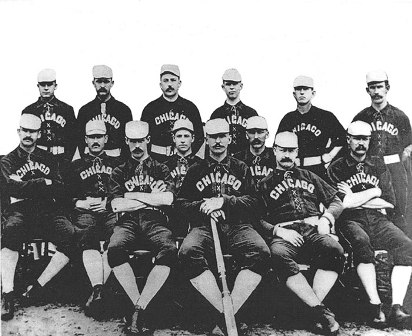Frank Isbell of the Chicago White Sox started hitting in 1905—having never hit better than .257, and after batting just .210 the previous season, Isbell posted a .296 average in 351 at bats in ’05.

Frank Isbell
Hugh Fullerton of The Chicago Tribune suggested it was due to his bat, “Big Betsy.” Fullerton said:
“The early history of the bat is unknown, but it was believed Issy discovered Betsy in a lot of bats purchased by the club. He fell in love with her and was always ready when hits were needed.”
In 1906, Isbell led the Hitless Wonders’ regulars with a .279 average, and hit .308 in the World Series versus the Chicago Cubs, including four doubles in his first four at bats in game 5.
Publishers Press News Service said:
“Big Isbell was a tower of strength with the stick. Four crashing doubles the lanky Swede tore off and besides scoring three runs himself, he drove in three more.”
Isbell added three more hits in game 6, and according to The Chicago Record-Herald, Isbell told Sox owner Charles Comiskey he was going to retire Betsy:
“That grand old bat has seen its last hard work on the ball field. It’s going to pass the rest of its days in peace. That stick helped skin the Cubs…Oh, it’s a great bat, but you’ll never see it on a ball field again. That’s the souvenir I prize above all the rest.”
Isbell changed his mind during the off season.

Isbell
Charles Dryden of The Tribune told the story of Big Betsy’s debut in 1907:
“By far the most important arrival of (opening) day was Big Betsy, which traveled by registered letter from Wichita, Kansas. She is too priceless to be risked any other way. Big Betsy is the bat from which the talented Mr. Isbell fired four two-baggers in the fifth game of the World’s Series. News that Betsy had reported sent some high grade chills chasing up and down the spine of the (St. Louis) Browns.”
Isbell, Dryden said, had brought the bat to Mexico City where the Sox trained in 1907, and when he later took a train from New Orleans home to Wichita, “Izzy took a top berth and let Betsy have the lower.” Isbell then shipped the bat to St. Louis for the opener because, “He had two grips, one in either hand, and there was no secure place for Betsy. He would not trust the porter.”
Dryden said the bat arrived the Southern Hotel in St. Louis at 11 o’clock on the morning of the game:
“Oozy Ed Walsh helped Izzy receive the stick and together they fondled it with loving hands. It was Oozy Ed who trained Big Betsy, using her to hit fungoes with in practice.
“The same tarred tape is sticking to the handle, and across the butt end of the weapon Izzy had carved lifelike portraits of the love doubles he smote on that fearful West Side day.”
Four days later with Isbell slightly hobbled by a leg injury, tragedy struck Big Betsy in Detroit. Dryden said in The Tribune:
“Izzy is in a bad way mentally and physically. Big Betsy, the fat bat that brought fame and dollars, is no more. Her shattered fragments wound about with crepe and forget me nots now are in the baggage coach ahead, bound for Wichita, Kansas. The remains will be framed and hung up in Izzy’s boudoir for future generations to rubber. It was G. (Sox Shortstop, George) Davis who put Big Betsy in the morgue. He borrowed her yesterday when Izzy was not looking and busted Betsy wide open hitting into a double play.”
Without Big Betsy and hampered by a season-ending hand injury in August, Isbell hit just .243 in 1907, he hit .247 in 1908 after holding out until June, and .224 in 1909. Isbell requested, and was granted, his release by Comiskey before the 1910 season in order to accept an offer to become player-manager of his hometown Wichita Jobbers in the Western League.


Leave a comment